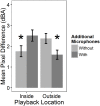Uncovering Spatial Variation in Acoustic Environments Using Sound Mapping
- PMID: 27467503
- PMCID: PMC4965030
- DOI: 10.1371/journal.pone.0159883
Uncovering Spatial Variation in Acoustic Environments Using Sound Mapping
Abstract
Animals select and use habitats based on environmental features relevant to their ecology and behavior. For animals that use acoustic communication, the sound environment itself may be a critical feature, yet acoustic characteristics are not commonly measured when describing habitats and as a result, how habitats vary acoustically over space and time is poorly known. Such considerations are timely, given worldwide increases in anthropogenic noise combined with rapidly accumulating evidence that noise hampers the ability of animals to detect and interpret natural sounds. Here, we used microphone arrays to record the sound environment in three terrestrial habitats (forest, prairie, and urban) under ambient conditions and during experimental noise introductions. We mapped sound pressure levels (SPLs) over spatial scales relevant to diverse taxa to explore spatial variation in acoustic habitats and to evaluate the number of microphones needed within arrays to capture this variation under both ambient and noisy conditions. Even at small spatial scales and over relatively short time spans, SPLs varied considerably, especially in forest and urban habitats, suggesting that quantifying and mapping acoustic features could improve habitat descriptions. Subset maps based on input from 4, 8, 12 and 16 microphones differed slightly (< 2 dBA/pixel) from those based on full arrays of 24 microphones under ambient conditions across habitats. Map differences were more pronounced with noise introductions, particularly in forests; maps made from only 4-microphones differed more (> 4 dBA/pixel) from full maps than the remaining subset maps, but maps with input from eight microphones resulted in smaller differences. Thus, acoustic environments varied over small spatial scales and variation could be mapped with input from 4-8 microphones. Mapping sound in different environments will improve understanding of acoustic environments and allow us to explore the influence of spatial variation in sound on animal ecology and behavior.
Conflict of interest statement
Figures







Similar articles
-
Effects of Previous Acoustic Experience on Behavioral Responses to Experimental Sound Stimuli and Implications for Research.Adv Exp Med Biol. 2016;875:1191-6. doi: 10.1007/978-1-4939-2981-8_149. Adv Exp Med Biol. 2016. PMID: 26611086
-
Diversity in ambient noise in European freshwater habitats: noise levels, spectral profiles, and impact on fishes.J Acoust Soc Am. 2007 May;121(5 Pt1):2559-66. doi: 10.1121/1.2713661. J Acoust Soc Am. 2007. PMID: 17550155
-
Speech intelligibility in noise using throat and acoustic microphones.Aviat Space Environ Med. 2006 Jan;77(1):26-31. Aviat Space Environ Med. 2006. PMID: 16422450
-
Measuring acoustic habitats.Methods Ecol Evol. 2015 Mar;6(3):257-265. doi: 10.1111/2041-210X.12330. Epub 2015 Jan 27. Methods Ecol Evol. 2015. PMID: 25954500 Free PMC article. Review.
-
Soundscapes and Larval Settlement: Characterizing the Stimulus from a Larval Perspective.Adv Exp Med Biol. 2016;875:637-45. doi: 10.1007/978-1-4939-2981-8_77. Adv Exp Med Biol. 2016. PMID: 26611014 Review.
Cited by
-
An Acoustic Camera for Use on UAVs.Sensors (Basel). 2023 Jan 12;23(2):880. doi: 10.3390/s23020880. Sensors (Basel). 2023. PMID: 36679677 Free PMC article.
References
-
- Vitousek PM, Mooney HA, Lubchenco J, Melillo JM. Human domination of Earth's ecosystems. Science 1997;277: 494–499.
-
- Warren PS, Katti M, Ermann M, Brazel A. Urban bioacoustics: it's not just noise. Anim Behav. 2006;71: 491–502.
-
- Gill SA, Job JR, Myers K, Naghshineh K, Vonhof MJ. Toward a broader characterization of anthropogenic noise and its effects on wildlife. Behav Ecol. 2015;26: 328–333.
MeSH terms
LinkOut - more resources
Full Text Sources
Other Literature Sources

